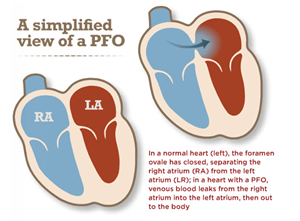A Patent Foramen Ovale (PFO) is a small hole between the left and right upper chambers of the heart. While everyone is born with this hole, it typically closes on its own. A PFO exists when that hole doesn’t close naturally.
According to the American Heart Association (AHA), about 25% of Americans have a PFO. Many people with a PFO are unaware of it and do not experience any health problems. However, for a small number of patients, a PFO can increase the risk of stroke, transient ischemic attack (TIA), and heart attack. The AHA reports that up to half of patients who have had a stroke of unknown cause, or who have had a stroke before age 55, have a PFO.
A hole in the heart itself does not cause a stroke. Instead, the hole allows blood to flow between the right and left chambers of the heart. Problems can arise if a blood clot travels through the hole to the brain, potentially causing a stroke.
Holes in the Heart
PFO information from the American Heart Association
Testing
Specialized testing is needed to detect a PFO. This may include:
- Echocardiogram (echo): an ultrasound of the heart to check blood flow across the heart valves and chambers.
- Transesophageal echo (TEE): an ultrasound of the heart that provides information about size, structure and function. This allows physicians to see the overall health of your heart, including the function of your heart valves and chambers.
- Bubble study: done during an echo or TEE, an IV-filled with agitated saline is placed in your arm. The saline makes bubbles that are monitored to see if they move from one side of the heart to the other.
Treatment
If treatment is needed, your cardiologist will consult with your neurologist on a plan. Possible treatment options may include:
- Blood thinning medication to prevent blood clots and stroke
- Device closure using cardiac catheterization
- Minimally-invasive surgical repair, where the PFO is closed by placing a small device across the hole in the heart through the vein in the leg

